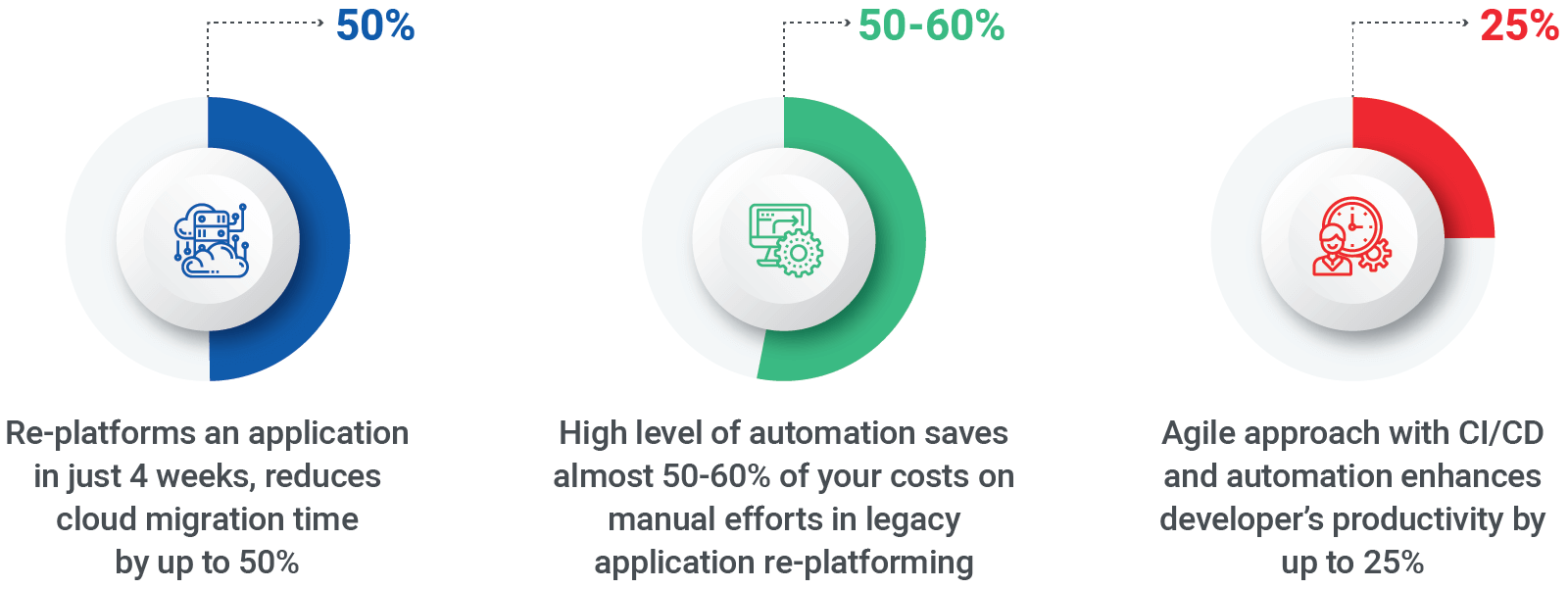Hexaware Acquires SMC Squared, a Leader in Building Global Capability Centers-Rolls Out GCC 2.0 Service Line. Learn More
This website uses cookies. By continuing to browse the site, you are agreeing to our use of cookies
Are you Migrating Applications to the Cloud?
Cloud
August 7, 2020
In these times of uncertainity, businesses are looking to digital leapfrogging to embrace agility, build resilience and future-proof themselves for all weather scenarios. A holistic approach to cloud adoption to realize intended value is easily said than done. This post takes a birds-eye view of migrating applications to the cloud, the strategies involved, how automation can make a difference, the business benefits and how the cloud can be an enabler of business transformation.
What is Application Migration to the Cloud?
Application Migration to the Cloud is the process of moving on-premises or legacy infrastructure to the cloud. It also would apply to moving applications, databases and IT processes from one cloud to another. Moving applications to the cloud would require organizations to review each application architecture, assess its feasibility for the new platform and make empowered choices. It is imperative to take a close look at your application migration criteria holistically factoring in specific compute requirements, resource allocation, business continuity, compliance, security and cost parameters.
Why Migrate to the Cloud?
The cloud has firmly taken root as the definitive destination for digital evolution. The enticing mix of massive computing muscle, unmatched agility and immediate scalability resting on a sustainable cost model is too hard to ignore. The benefits are pragmatic and boundless. In an era of uncertainty and disruption, businesses need to look beyond the horizon. They need to work on an IT system that would create a growth model built on agility, resilience and disruptive innovation. The cloud fits the bill perfectly. The silver lining is all too obvious. A holistic cloud strategy is a natural part of the broader business roadmap, the pivot to an IT transformation plan focussed on tangible outcomes. Cloud computing is here to stay and grow – for enterprises, vendors, brokers, service providers and the entire ecosystem.
What are the Application Migration Strategies
It is very important to have your feet on the ground when looking to shift to the cloud. Your application migration strategy should be tightly aligned with core business goals and also take a deep dive into the environment, the interdependencies, the architecture and current licensing arrangements. The three most common application migration strategies at the broader level are
- Rehosting
- Re-platforming
- Refactoring
Let’s look at each of these approaches in a little more detail.
1. Rehosting
Also known as “lift and shift”, organizations gravitate towards this approach when there is a need to get the migration done quickly based on supporting business cases. Moving applications to the cloud using the Rehost route is a rapid and smoother migration process with minimal application disruption. It will only require a change to the host configuration since there is new cloud-based hardware in play. A lift and shift context would also entail ruling out cloud-native benefits like continuous real-time deployment. There is also the possibility of sub-optimal performance. Organizations with time and cost constraints or have a lot of commercial or off-the-shelf applications find the lift and shift method a better fit for their business goals.
2. Replatforming
Also referred to as “lift-tinker-and-shift”, the application or a part is optimized to increase resilience and enhance scalability before moving to the cloud. This approach which is increasingly become popular involves due diligence and analysis. The code is refactored by adopting modern frameworks like APIs and microservices. It might involve transformation from old technology to a new one or code generation for new features needed on the cloud. Optimization allows for faster lifecycles for applications through real-time updates once they are in the cloud. Organizations looking to automate certain defined processes before moving to the cloud are more likely to adopt this migration path. Replatforming is ideal for legacy application modernization and offers the highest TCO reduction possible.
4. Refactoring
Refactoring is the way to go if you are looking at market competitiveness with major code modifications for enhanced service capabilities, improved performance and speed. It might involve changes in the application architecture and leverage cloud-native features for performance benefits. The disadvantage though is that the more cloud-native the application is, you will be tightly coupled to the cloud you are using. The refactoring route offers greater opportunities for innovation and automation but also comes at higher costs and longer implementation times. Since there are changes to the application at many levels there are a higher probability for errors at the code, configuration and infrastructure levels. It is thus essential to ensure that your cloud readiness assessment is spot on when deciding on the migration journey.
Benefits of Application Migration to the Cloud
Cloud computing, adoption, and migration is an essential strategy to accelerate digital transformation at lower costs. In the age of the digital disruptive, businesses with on-premise legacy infrastructures simply cannot afford to lag behind. A holistic roadmap with a differentiated approach aligned to enterprise goals makes all the difference to thrive in a cloud-first world. Being re-born-in-the-cloud today can offer unparalleled benefits as listed down below.
- Guaranteed reduced IT costs
- Ability to scale operational needs seamlessly
- Business continuity in all-weather scenarios
- Increased collaboration and cohesion
- Enhanced mobility and responsiveness
- Easier government compliance
- Improved data security and control
- Flexibility to focus more on the business bottom line
- Actionable business insights for growth
- Greater focus on Quality Assurance
- Automatic Software updates
- Sustainability and reduced carbon footprint
- A clear competitive advantage
Cloud and Application Migration Challenges
While cloud computing has the ability to unlock deep strategic value through increased business agility, the path towards migrating applications to the cloud is dotted with many challenges. Your strategic cloud migration strategy needs to plan for potential bottlenecks, costs, security and flaws in the implementation process. The primary challenges that needs careful review and clear navigation at a broader level are listed down below.
- Cost evaluation and optimization
- Legacy of technology
- Application prioritization
- Risk Assessment and Security
- Skill gaps and expertise
- Compliance & Regulations
- Multi-Cloud Management
- Performance and Monitoring
- Data Analytics and Insights
- Segmented usage and adoption
- Governance and best practices
- Migration effectiveness and ROI
- People and Culture
Application Replatforming with Automation for Cloud Mass Migration
While cloud migration approach strategies work on a horses for courses best-fit model, one increasingly popular approach is application replatforming driven by automation. Automation offers replatforming the highest TCO reduction promise, perfect for legacy systems with substantial returns in migration times and cost savings. Getting on the automation bandwagon can ensure that your application code assessment for refactoring and cloud readiness can be finished in a matter of hours. The entire replatforming journey for legacy applications when using the right automation led tool can be closed in just six weeks while manual methods can take anywhere between six to nine months.
Amaze® – Hexaware’s proprietary automated application replatforming solution for mass cloud migration
Pushing the envelope of automated cloud refactoring is Hexaware’s amaze® for applications, a re-platforming solution that can accelerate the cloud journey by reducing cloud adoption time by 75% and implementation costs by up to 60%. Amaze® can automatically analyze applications, replatform them based on criticality and move them to any public cloud platform. Its automation expertise has been specifically tailored to move your legacy Java and C# sharp applications along with all its dependencies like databases, message brokers and schedulers to a cloud-friendly stack and design pattern.
Amaze® cuts down on time across all stages to deliver application mass migration with great efficiency and does the following
- Break the monolith into macro services
- Make macro services stateless, infinite and scalable
- Headless architecture for digital enablement
- Replatform old technologies to become cloud friendly with a preference for free open source tech
- Database migration and CI/CD deployment

The pace of automation led replatforming makes for an accelerated journey – 2 weeks to analyze your application, 24 hours for a readiness report and just 4 weeks to refactor and move to the cloud. The considerable benefits including a 50% reduction in the total cost of transforming and refactoring an application, a 30 % increase in productivity and a 40 per cent reduction in time to market.
Realize TCO Benefits in your Cloud journey
The most crucial key question that is on top of the mind of every CxO would be TCO savings. Especially in uncertain times when organizations need to keep abreast of twin fold objectives of treading caution and yet unravel opportunities for resilience and growth. Also, different cloud migration approaches have varied impacts on TCO and are aligned to each organization’s unique needs. The road ahead for ROI then pivots to a model that has automation at its core and has the pragmatic potential to do away with various license costs and score big on increased application performance and development productivity.
Taking amaze® as a ready reference for better understanding, in most cloud replatforming initiatives, ROI starts at the singular point, the break-even, when the cost to replatform the application to the cloud is recovered by a reduction in the monthly operating cost. Due to automation accelerating the journey, the attractive proposition is that investments start giving positive returns from the first month itself. Adopting open-source software like Tomcat, Spring and Postgres can further reduce licensing costs substantially. An outcome based delivery model will strengthen the ROI paradigm even further.
Conclusion
As the cloud creates significant opportunities for increased business agility, early as well as high adopters have realized multi-fold business value. Costs savings, increased operational efficiencies, enhanced security and innovation in enabling new technologies have helped organizations win on many fronts. Agile organizations looking to move the needle for competitive advantage also understand it is about the right time to future-proof themselves for all weather scenarios. The importance of the cloud has never been greater today. While the basic building blocks for migrating applications to the cloud remain the same – application prioritization, risk assessment and cost evaluation, Automation is the definitive game changer for the morrow and beyond.
Talk to our cloud experts to know how we can simplify, automate and accelerate your cloud journey. Lets have a conversation now.
Related Blogs

Understanding Snowflake Cortex for Gen AI Applications with Sensitive Data
- Generative AI
- Cloud
- Data & Analytics

Ready to Pursue Opportunity?
Every outcome starts with a conversation

















